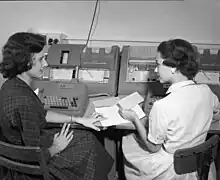Data entry is the process of digitizing data by entering it into a computer system for organization and management purposes. It is a person-based process[1] and is "one of the important basic"[2] tasks needed when no machine-readable version of the information is readily available for planned computer-based analysis or processing.[3]
Sometimes what is needed is "information about information (that) can be greater than the value of the information itself."[4] It can also involve filling in required information which is then "data-entered" from what was written on the research document, such as the growth in available items in a category.[4]: 68 This is a higher level of abstraction[5] than metadata, "information about data."[6] Common errors in data entry include transposition errors, misclassified data, duplicate data, and omitted data, which are similar to bookkeeping errors.
Procedures
Data entry is often done with a keyboard and at times also using a mouse,[7] although a manually-fed scanner may be involved.[8]
Historically, devices lacking any pre-processing capabilities were used.[9]
Keypunching

Data entry using keypunches was related to the concept of batch processing – there was no immediate feedback.[10][11]
Computer keyboards
Computer keyboards and online data-entry provide the ability to give feedback to the data entry clerk doing the work.[12][13]
Numeric keypads
The addition of numeric keypads to computer keyboards[14] introduced quicker and often also less error-prone entry of numeric data.[15]
Computer mouse
The use of a computer mouse, typically on a personal computer, opened up another option for doing data entry.[16]
Touch screens
Touch screens introduced even more options, including the ability to stand and do data entry,[16] especially given "a proper height of work surface when performing data entry."
Spreadsheets
Although most data entered into a computer are stored in a database, a significant amount is stored in a spreadsheet.[17] The use of spreadsheets instead of databases for data entry can be traced to the 1979 introduction of Visicalc,[18] and what some consider the wrong place[19] for storing computational data continues.[20]
Format control[21] and specialized data validation are reasons that have been cited for using database-oriented data entry software.[22][23]
Data managements
The search for assurance about the accuracy of the data entry process predates computer keyboards and online data entry.[24][25] IBM even went beyond their 056 Card Verifier and developed their quieter IBM 059 model.[26]
Modern techniques go beyond mere range checks, especially when the new data can be evaluated using probability about an event.[27]
Assessment
In one study, a medical school tested its second year students and found their data entry skills – needed if they are to do small-scale unfunded research as part of their training – were below what the school considered acceptable, creating potential barriers.[2][28]
See also
References
- ↑ "Data entry ... Person based jobs" "Work from home".
- 1 2 Khan, A. M.; Shah, D.; Chatterjee, P. (2014). "Journal of Family Medicine and Primary Care (Q3, 2014)". Journal of Family Medicine and Primary Care. 3 (3): 216–218. doi:10.4103/2249-4863.141613. PMC 4209675. PMID 25374857.
- ↑ "A Primer on Machine Readability for Online Documents and Data".
- 1 2 Nicholas Negroponte (1995). Being Digital (C) 1995. p. 154. ISBN 978-0-679-43919-6.
- ↑ EH McKinney (June 1, 2010). "Information about information: a taxonomy of views".
- ↑ "metadata".
- ↑ J. F. Thomsen (2008). "Carpal tunnel syndrome and the use of computer mouse and keyboard".
- ↑ Miracel Griff (2014). Professional Accounting Essays and Assignments. ISBN 978-1312069312.
- ↑ "Data Preprocessing Techniques for Data Mining" (PDF).
- ↑ "Information Technology".
- ↑ "How hardware and software contribute to efficiency and effectiveness".
- ↑ "US6970158B2 - Computer keyboard providing an alert when typing".
- ↑ The Electronic supervisor : new technology, new tensions. DIANE. 1987. ISBN 978-1428922761.
- ↑ "What Is Ten-Key Data Entry?".
- ↑ "Learning Numeric Data Entry". January 27, 2015.
- 1 2 "An Ergonomic Comparison of Data Entry Work Using a Keyboard vs.Touch Screen Input Device While Standing and Sitting". Journal of Ergonomics. 2014.
- ↑ "Comparing Databases and Spreadsheets for Storing Data". December 1, 2003.
- ↑ "... a few minutes of data entry. For example, a simple spreadsheet might hold payroll information with columns for ..." "Spreadsheet".
- ↑ "Spreadsheet Does Not = Database". PCmag.com. February 3, 2004.
- ↑ D. Birch (2018). "The Future of Spreadsheets in the Big Data Era".
- ↑ (New Jersey's Kenilworth's zip code is 07033, for example, and not 7033, without the leading zero)
- ↑ "Database and Spreadsheet".
- ↑ "... and it's our old friend the database. ... allowing you to define the tables, data-entry screens" "7 spreadsheet problems... and how to solve them".
- ↑ "IBM 056 card verifier" Card/tape writer. United States Department of the Army. 1977. p. 249.
- ↑ "IBM 056 Card Verifier" (PDF).
- ↑ "IBM 059 Card Verifier" (PDF).
- ↑ "In a situation where one can obtain probabilistic information about an event, it may also be possible to learn something about the reliability of that info." S. Savari (2001). "Information about information". Proceedings. 2001 IEEE International Symposium on Information Theory (IEEE Cat. No.01CH37252). p. 22. doi:10.1109/ISIT.2001.935885. ISBN 0-7803-7123-2. S2CID 60979002.
- ↑ "found to be lacking in more than half of the respondents."